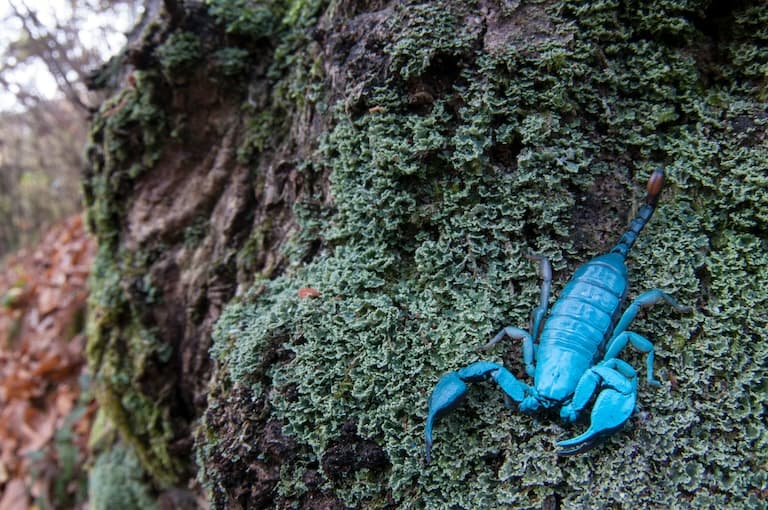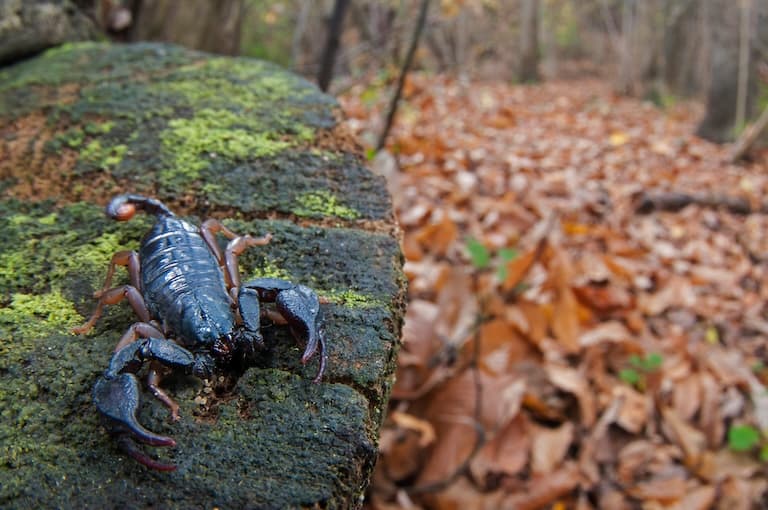European Yellow-tailed Scorpion Profile
Scorpions are primarily a tropical group of arachnids. Despite evolving on the planet longer than almost everything else around today, they still haven’t figured out how to tolerate the cold.
So, when a small batch of them shows up in Kent in the UK and appears to do quite well, it’s definitely newsworthy.
The European yellow-tailed scorpion is unusual in that it’s more tolerant of the drizzle than other scorpions, and its preference for hiding away and not really doing anything with itself means it fits right in.

European Yellow-tailed Scorpion Facts Overview
| Habitat: | Cracks, crevices, dry, dark spaces |
| Location: | Southern Europe, North Africa, UK, Uruguay |
| Lifespan: | Maturity after 1-2 years, maximum lifespan not clear |
| Size: | Around 4 cm (1.6 in) long |
| Weight: | Up to 1.1 g (0.04 oz) |
| Colour: | Black or brown body, yellow and black legs and a yellow venom bulb |
| Diet: | Small invertebrates |
| Predators: | Birds, bats, mammals |
| Top Speed: | Slow |
| No. of Species: | 1 |
| Conservation Status: | Not Listed |
This is a very small scorpion from a large family of European scorpions, the vast majority of which are never seen by anyone North of Paris.
But this little one has a habit of hopping on ships and has made its way to non-native lands, where it remains notably polite by ecological standards.
These scorpions don’t cause any damage, nor can they really harm people. They simply get by at a very slow pace.
Interesting European Yellow-tailed Scorpion Facts
1. They’re part of a widespread European family
The taxonomy of scorpions, like that of most arthropods, is still being modified as new information comes out. As it stands, the family Euscorpiidae is a family of mostly European scorpions fitting into six genera and 114 species.
There are a couple around the Mediterranean coast of Africa and at least one in Guatemala for some reason (more on that later), but by and large, these are proud, European scorpions.
The yellow-tailed scorpion is a little one, growing no more than 4cm long, and is native to the warmer parts of Europe, but its specific taxonomic status is under review and may change very soon. 1

2. They’re good mothers
Females hold onto their eggs, and won’t lay them until they’re already almost hatching. Once laid, the hatchlings pop out very quickly and hitch a ride on her back until they’re big enough to go it alone.
This process takes almost a year from fertilisation to independence, and the diligence of the mother is critical to their success. And they are often successful!
3. They’re found in the UK
This species of scorpion loves dark cracks and crevices (which is what the UK is known for), but it also prefers dry environments, and as it’s rained incessantly in Britain since it stopped snowing there, this is a bit strange.
But this species isn’t native to the UK, or incidentally, to Uruguay, where it’s also been spotted. It’s a stowaway, having hitched a lift on imports from the Southern regions of the continent, likely on masonry shipments from the 1800s.
In the UK, it takes advantage of the bountiful woodlouse populations and isn’t causing any harm to the ecosystem so it’s not considered invasive.
This sneaky little scorpion is now the only official scorpion in the UK, and the northernmost species of scorpion in the world, and like the majority of scary and dangerous animals in Britain, it’s almost entirely harmless.

4. They’re ambush predators
The European yellow-tailed scorpion isn’t one for moving around a lot. It finds a crack or crevice and hunkers down, sitting spiderlike in wait for prey to do the heavy lifting.
It’s capable of short bursts of speed, which it uses to lunge out and grab passers-by, and in this case, these victims are mostly woodlice.
If woodlice are thin on the ground, this species is known to pick on members of its own species, and in either case, the prey is grabbed with the powerful claws and incapacitated with its venomous sting, but its venom isn’t likely anything to worry about it. 2
5. They’re mildly venomous
The sting of this scorpion is more attuned to immobilising small creatures like crickets and woodlice, and this species isn’t all that eager to use it in self-defence. There are few reports of stings on people, and those that can be found liken it to a bee sting, or even as mild as a pinprick.
This is an example of the general rule that if a scorpion has large, muscly pincers, it’s less likely to be dangerous. It’s commonly said that species with smaller pincers are the ones to watch out for, as they likely compensate for their reduced strength with a more powerful sting.
However, no rule is absolute, and even within generally harmless species, there can be exceptions.
At least one case report details a 10-year-old boy thought to have been stung by this species, and who experienced more severe symptoms including weakness in the affected arm, abdominal cramps and muscle twitches.
Still, these all subsided within 72 hours, and the species was only inferred by regional data, rather than a direct identification.
6. They’re not very sociable
One of the reasons most people aren’t worried about this species becoming invasive is that they’re not a very active lot.
Popping out to grab a woodlouse every once in a while, really takes it out of them, and they’ll spend the majority of their time motionless, just loitering mindlessly like British teenagers ever since the government scrapped youth centres.
They tend to only come together for mating, which is a season that is longer in the South than the North due to the extended warm weather periods.
But being so unsociable, they have to struggle to find one another, and this means that when a male finally gets his claws into a female, he will defend her aggressively, standing guard outside her crack until she becomes ready to invite him inside.
Scorpion sex is more like an exchange of presents in an Anime cartoon than the kind of copulation you might be used to finding on the internet.
There’s a brief courtship dance, which is very cute, and then the male places a packet of sperm on the ground for her, which she accepts, blushing and giggling as she picks it up.
And that’s about the extent of their yearly exercise.

7. They’re not very active at all
Aside from mating and literally lunging at four or five woodlice a year, this scorpion does almost nothing for its entire life.
It’s a wonder it managed to get onto ships in the first place, but unlike the notorious Brazilian wandering spider that had to climb a banana tree, this one was likely picked up when humans piled a bunch of rocks onto boats.
Its remarkably slow metabolism means it only has to eat once every couple of months or more, so it mostly just stays sitting there in the cracks. 3
European Yellow-tailed Scorpion Fact-File Summary
Scientific Classification
| Kingdom: | Animalia |
| Phylum: | Arthropoda |
| Class: | Arachnida |
| Order: | Scorpiones |
| Family: | Euscorpiidae |
| Genus: | Euscorpius (Tetratrichobothrius) |
| Species: | flavicaudis |
Fact Sources & References
- Laurie (1896), “EUSCORPIIDAE”, The Scorpion Files.
- Jennifer Akre “Encyclopedia of Life Euscorpius flavicaudis”, Animal Diversity Web.
- De Geer (1778), “Tetratrichobothrius flavicaudis”, English Wikipedia.
